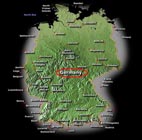Berlin tourism archive contains a host of travel secrets
 Berlin - Colourful posters, brochures and travel books, some dating back to the 17th century, line the shelves of Germany's biggest tourism archive.
Berlin - Colourful posters, brochures and travel books, some dating back to the 17th century, line the shelves of Germany's biggest tourism archive.
Germans have long been prolific travellers, and it's easy to see why when you comb through the literature at the Free University's Willy-Scharnow Institute for Tourism in south-west Berlin.
It contains a trove of travel literature, much of it related to 19th and 20th century travel, and to the phenomenal growth of the German tourism industry in the past 80 years.
The archive covers various aspects of tourism, not only within Germany, but also in countries like China, Japan, Nepal, Togo (once a German protectorate), Morocco, India and Australia.
In addition, it has a wealth of material on tourism development across Europe. Some 50,000 travel magazines, leaflets and posters, plus other tourist-related material are housed in the archive.
The archive was created in the late 1980s, at a time when interest in foreign travel was surging to record levels - in the wake of the nation's booming economy. With more money in their pockets, Germans weren't shy about spending it.
Relentless explorers often headed to far-flung corners of the world - in search of exciting new holiday experiences. Baedeker travel guides, first published in the country in
1832, remain "must" reading by many planning trips abroad.
Between 1832 and 1945 some 1,000 Baedeker editions were printed, initially in German, but later also in French and English. They focused not only on European countries, but also on the Middle East, India, the United States, Canada and Latin America. Numerous early editions of Baedeker are to be seen at the archive.
"Tourism is a mirror image of our society, reflecting many political and socio-historical aspects," says Hasso Spode, 57, director of the Berlin archive.
Many of the travel books and documents stem from collections donated by private individuals and organizations. A few months ago, the Willy Scharnow Institute for Tourism announced it would not be accepting any further students, due in part to funding cut-backs.
This, inevitably sparked concerns about the future of the archive. Professor Spode, a cheerful Berlin-bred academic, however, dismisses rumours that it will now have to close.
"The FU wants to keep the archive as a "tourism cultural research centre," he says.
If the idea is approved, it means historians, researchers and students will continue to be granted access to the archive.
"Such is the size of the archive that some of the material still needs sorting," says Professor Spode.
In the 1920s, Berlin was a bustling newspaper metropolis, turning out hundreds of newspapers, magazines and illustrated periodicals. This is reflected in the wealth of travel magazines and journals found at the archive from that period. Around 1930 the first scientific institute for foreign travel research was based in Berlin, says Spode. Curiously, when the Nazis arrived on the political scene in Germany the growth of tourism was not negatively affected.
"Quite the reverse in fact," he says. "They (the Nazis) adopted a systematic policy of commercial tourism research. The result was the number of foreign visitors arriving in Germany from America, Britain and France actually increased in the 1930s."
An illustrated travel periodical produced at the time of the Nazi-staged Olympic Games in 1936 was unabashedly titled Deutschland. Skilfully produced, it avoided political overtones and Nazi symbols.
"Its message was clear: come to Germany and see for yourselves what a modern country we are, and what progress is being made here" notes Spode.
The strategy paid off, and the periodical became very popular. Copies of the magazine, which ceased publication at the height of World War II in 1943, are to be found in the archive.
A book on China, written in English, and dating back to the 16th century is the oldest printed work found at the archive. There are also travel books with pungent references to Germany authored by famous American writer Mark Twain, dating from the late 19th century.
Professor Spode says a trio of large collections on tourism growth donated to the FU Institute by private individuals and organisations have helped swell the size of the Berlin archive in recent years.
"We have no end of sources," he told Deutsche Presse-Agentur dpa during a tour of the archive.
"People send us cartons containing photo albums, complete with personalised descriptions of their travels abroad."
In a separate nearby room, early post-war German travel posters are displayed, revealing how tourist officials sought to lure back foreign visitors after the war. One of the posters features the nation's most famous writer, Goethe.
"The poster is hardly inspiring, but then it wasn't easy promoting Germany after all that had happened in the Nazi era," said Spode. (dpa)